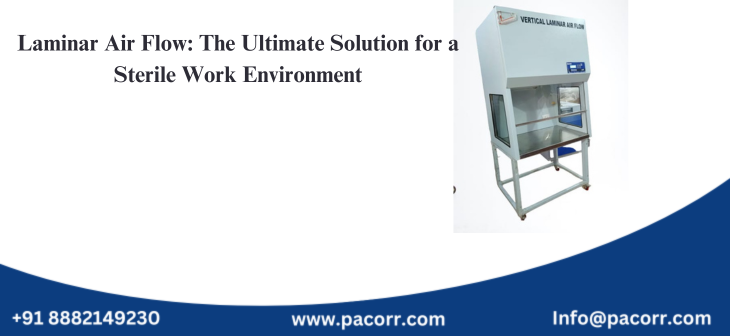
Laminar Air Flow is a highly efficient system designed to maintain a contaminant-free workspace by controlling airborne particles. It plays a crucial role in industries that require sterility, such as pharmaceuticals, biotechnology, healthcare, and research laboratories. By ensuring a smooth, unidirectional airflow, it provides a clean and controlled environment, protecting sensitive materials from contamination.
Understanding the working principle, applications, and benefits of Laminar Air Flow helps in selecting the right system for maintaining sterility and efficiency in various industries.
What is Laminar Air Flow?
Laminar Air Flow is a specialized workstation engineered to deliver filtered, particle-free air in a controlled manner. It uses HEPA or ULPA filters to remove airborne contaminants, ensuring a clean workspace where delicate operations are performed. By maintaining a constant airflow direction, it prevents external pollutants from interfering with processes that require a high level of hygiene and precision.
Designed to eliminate dust, microbes, and other particles, Laminar Air Flow is an essential tool for ensuring sterility in environments where contamination can compromise research, production, or patient safety.
How Does Laminar Air Flow Work?
The working principle of Laminar Air Flow is based on unidirectional airflow that moves at a constant speed, preventing turbulence and cross-contamination. The process involves:
- Air Intake: Ambient air is drawn into the system through a pre-filter that captures larger particles.
- Filtration: The air passes through a HEPA or ULPA filter, removing up to 99.99% of particles as small as 0.3 microns.
- Airflow Distribution: The clean air flows evenly across the workspace in either a horizontal or vertical direction, ensuring a sterile working area.
- Contaminant Removal: The continuous flow of filtered air pushes contaminants away from the work surface, maintaining cleanliness.
This precise airflow control makes Laminar Air Flow indispensable in settings that demand a sterile and controlled environment.
Types of Laminar Air Flow
Different Laminar Air Flow configurations are designed to meet industry-specific requirements:
1. Horizontal Laminar Air Flow
- Air moves horizontally from the rear of the cabinet toward the user.
- Ensures direct protection of samples but does not safeguard the operator from hazardous substances.
- Used in electronics manufacturing, pharmaceutical testing, and laboratory research.
2. Vertical Laminar Air Flow
- Air flows vertically from the top to the work surface.
- Provides both sample and user protection by directing contaminants downward.
- Ideal for medical research, microbiology, and sterile drug preparation.
Applications of Laminar Air Flow
The controlled airflow system is widely used across industries where sterility and contamination control are essential:
1. Pharmaceutical Industry
- Provides a sterile zone for drug formulation and handling of sensitive compounds.
- Ensures aseptic conditions in vaccine production and sterile packaging.
2. Research and Microbiology Laboratories
- Maintains a contamination-free environment for bacterial and viral culture studies.
- Essential for DNA research, genetic engineering, and clinical testing.
3. Healthcare and Medical Facilities
- Used in operating rooms and cleanrooms to minimize airborne infection risks.
- Helps in tissue culture, pathology labs, and in-vitro fertilization (IVF) procedures.
4. Electronics and Semiconductor Industry
- Prevents static discharge and dust accumulation in chip manufacturing and circuit assembly.
- Ensures precision in semiconductor and microprocessor fabrication.
Key Features of Laminar Air Flow
A high-quality Laminar Air Flow system should include:
- HEPA/ULPA Filtration: Eliminates airborne contaminants with 99.99% efficiency.
- Stainless Steel Construction: Prevents rust, ensuring durability and hygiene.
- Low Noise and Vibration: Provides a quiet and stable working environment.
- UV Germicidal Lamp: Enhances sterilization by eliminating microbes.
- Energy-Efficient Blower: Reduces power consumption while maintaining optimal airflow.
- Ergonomic Design: Enhances comfort during prolonged operations.
Benefits of Using Laminar Air Flow
- Sterility Assurance: Ensures a contamination-free environment for sensitive processes.
- Enhanced Product Quality: Reduces risks of sample contamination in pharmaceuticals and research.
- User and Sample Protection: Provides a controlled airflow that minimizes exposure to contaminants.
- Regulatory Compliance: Meets ISO and GMP standards, essential for sterile production.
- Increased Efficiency: Reduces the chance of errors caused by airborne impurities.
How to Maintain Laminar Air Flow?
Proper maintenance is essential to ensure the longevity and efficiency of Laminar Air Flow. Key maintenance steps include:
- Filter Replacement: HEPA filters should be checked and replaced periodically.
- Regular Cleaning: Use sterile wipes and disinfectants to clean surfaces after each use.
- Routine Inspection: Ensure airflow velocity and pressure are within optimal range.
- Avoid Obstructions: Keep the airflow path clear for maximum efficiency.
- Annual Certification: Have the system professionally inspected and validated for compliance.
Choosing the Right Laminar Air Flow
Selecting the right Laminar Air Flow depends on specific workspace requirements. Factors to consider include:
- Type of Airflow: Choose between horizontal or vertical airflow based on protection needs.
- Filtration Efficiency: Ensure the system has HEPA or ULPA filters for superior air quality.
- Workspace Size: Select a model that fits available space without compromising efficiency.
- Safety Features: Look for UV sterilization, low noise levels, and durable construction.
Laminar Air Flow is an indispensable tool for industries that require a sterile and contamination-free environment. By ensuring a controlled airflow, it plays a crucial role in pharmaceuticals, laboratories, hospitals, and electronics manufacturing.
With proper selection, maintenance, and adherence to safety protocols, it guarantees long-term efficiency and protection for both operators and sensitive materials. Investing in a high-quality Laminar Air Flow system ensures compliance with industry standards while enhancing productivity and safety.
For advanced Laminar Air Flow solutions, it is important to choose a reliable manufacturer that delivers efficiency, durability, and superior contamination control.
Thanks to Pacorr Testing instruments, we have all the required quality testing instruments that have helped us to ensure the best quality delivered to our clients.

Danish
Fair Exports Pvt. Ltd.

